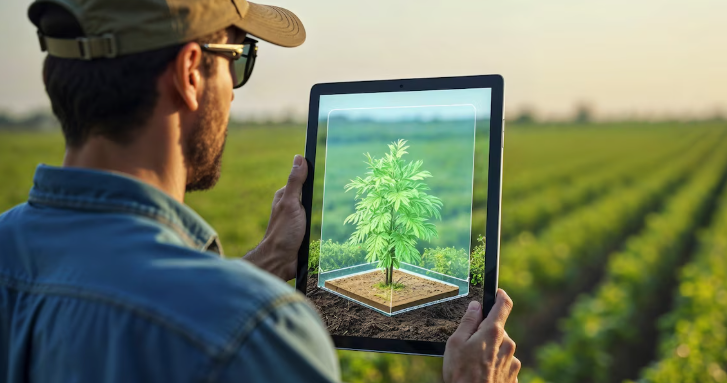AI in Agriculture: Enhancing Decision-Making on the Field
Across sun-drenched landscapes, a silent conversation unfolds. Crops whisper tales of their needs, of thirst and nutrient imbalances, of pest infestations and looming weather shifts. But for the modern farmer, these whispers are no longer unheard. Enter AI in agriculture, a transformative force that equips them with ears to listen, eyes to see, and the analytical prowess to enhance every decision made on the field. This blog post delves into the transformative power of AI in agriculture, showcasing its diverse applications, impactful benefits, and potential to revolutionize the future of farming.

Beyond Guesswork: Unveiling the Invisible with AI-Powered Insights
Precision Applied: Tailoring Care to Each Plant’s Individuality
Traditional farming often treated every plant within a field as a uniform entity. But AI in agriculture shatters this uniformity, revealing the unique needs of each individual plant. Imagine advanced software analyzing data from sensors and drone imagery, pinpointing specific areas requiring additional irrigation, targeted fertilizer application, or even pest control measures. Envision autonomous robots equipped with AI-powered navigation meticulously traversing your fields, delivering precise care to each plant based on its unique needs. This enhanced level of customization ensures no plant is left behind, allowing you to nurture every seed to its full potential and achieve record-breaking yields.
Resilience Built on Foresight: Weathering the Storm with AI-Driven Predictions
The agricultural landscape is no longer predictable. Unforeseen weather patterns and extreme events pose ever-increasing challenges. But AI in agriculture arms you with the power of foresight. Imagine advanced weather forecasting models powered by AI, analyzing vast datasets to predict impending frost, heavy rainfall, or pest outbreaks with laser-sharp accuracy. Envision intelligent irrigation systems adjusting watering schedules based on real-time weather data, preventing water waste and safeguarding your crops from drought stress. This AI-driven resilience allows you to proactively adapt to changing weather conditions, protecting your investments and ensuring your fields weather any storm, contributing to enhanced food security and stability.
Beyond Yield: Cultivating a Sustainable Future with Every Byte
AI in agriculture is not just about maximizing yields; it’s about nurturing a sustainable future for our planet. Imagine optimizing irrigation based on real-time soil moisture data, minimizing water waste and preserving precious resources. Envision precision fertilizer applications reducing chemical runoff and protecting water quality. This sustainability-focused approach, empowered by AI, ensures abundance thrives alongside environmental responsibility, safeguarding our planet’s resources for generations to come. With every AI-driven decision, you cultivate not just bountiful harvests but a thriving and sustainable ecosystem, leaving a legacy of environmental stewardship for future farmers.
Connecting Fields to the Cloud: The Power of Collective Intelligence
AI in agriculture thrives in a connected ecosystem. Imagine farmers across continents sharing data on specific soil types, crop varieties, and regional weather patterns through cloud platforms. Envision collaborating with agricultural experts and researchers around the globe, analyzing datasets fueled by AI to identify emerging trends and develop best practices applicable to diverse agricultural landscapes. This collaborative network fosters innovation, accelerates problem-solving, and empowers farmers to learn from each other’s successes, regardless of geographical location. With every shared insight, the agricultural community strengthens, propelling the industry towards a brighter future where enhanced knowledge flourishes without borders.
Data-Driven Decisions: From Intuition to Actionable Insights
AI in agriculture is a symphony of data, but its power lies in transforming data into action. Imagine real-time dashboards visually presenting key metrics, highlighting potential problems, and even suggesting optimized solutions powered by AI. Envision historical data and current conditions layered upon each other, revealing trends, patterns, and opportunities for improvement. This data-driven approach guides you towards informed decisions, allowing you to optimize resource allocation, predict potential problems before they arise, and navigate the complexities of modern agriculture with unparalleled clarity. With every actionable insight gleaned from AI, you transform intuition into enhanced decisions, propelling your farm towards a future of efficiency and abundance.
A Glimpse into the Future
AI in agriculture is constantly evolving, with cutting-edge advancements emerging each day. Imagine AI-powered robots conducting autonomous weed control, eliminating the need for harmful herbicides. Envision blockchain technology ensuring data security and traceability throughout the agricultural supply chain, creating a more transparent and efficient food system. This future promises even greater enhancement to decision-making, automation, and data analysis, further solidifying the role of AI in agriculture as the backbone of future-proof and sustainable farming practices.
Additional Resources
- The Future Landscape of Agriculture: Predictions and Innovations in Precision Farming
- Maximizing Harvest Potential: Mastering Precision Crop Management for Optimal Yields
- The Microbiome and Crop Health: A Symbiotic Relationship
- AI in Agriculture: Enhancing Decision-Making on the Field
Additional Learning
Categories
Latest Post’s
FAQs
What is AI in agriculture?
AI in agriculture refers to the use of artificial intelligence technologies, such as machine learning and computer vision, to automate and optimize farming practices. It allows for the collection and analysis of vast amounts of data to assist farmers in making more intelligent and efficient decisions.
How does AI help farmers with soil and crop health?
AI helps by analyzing data from soil sensors to assess moisture, pH, and nutrient content. AI algorithms can also process images from drones and satellites to identify signs of stress or disease in crops. This provides farmers with a detailed understanding of their fields’ health, allowing them to apply specific treatments.
Can AI help farmers with weather predictions?
Yes, AI is highly effective for weather prediction. It analyzes a combination of historical weather data and real-time atmospheric conditions to provide farmers with highly accurate, localized forecasts. This helps them plan for planting, irrigation, and harvesting to avoid weather-related crop damage.
How does AI contribute to sustainable farming?
AI promotes sustainability by optimizing resource use. For example, AI-driven irrigation systems can reduce water consumption by up to 30%, and targeted pest control methods can reduce the need for chemicals by up to 80%. These practices lessen agriculture’s environmental impact.
Is AI a solution for the global food crisis?
AI is a promising tool to help address the global food crisis. By increasing crop yields, reducing waste, and making farming more resilient to climate change, AI can help produce more food on less land with fewer resources, contributing to greater food security.
What is the difference between AI and IoT in agriculture?
IoT (Internet of Things) is the network of physical sensors and devices that collect data from the field. AI is the software and algorithms that analyze the data collected by those IoT devices to generate actionable insights and make decisions. They work together, with IoT providing the “senses” and AI providing the “brain.”
What are the main challenges for farmers in adopting AI?
The main challenges include the high initial cost of technology, a lack of reliable internet connectivity in many rural areas, and the need for farmers to acquire new technical skills. There are also concerns about data ownership and privacy.
How do AI-powered robots help with farm labor?
AI-powered robots can automate physically demanding, repetitive, and time-consuming tasks. These include weeding, planting, and harvesting. They can work continuously, addressing labor shortages and allowing human workers to focus on higher-level management tasks.
Can AI predict pest outbreaks?
Yes, AI systems can predict pest outbreaks with high accuracy. They analyze historical data on pest cycles, local weather conditions, and plant health to create predictive models. This early warning system allows farmers to implement preventive measures before an infestation occurs.
Is AI a substitute for a farmer’s experience?
AI does not replace a farmer’s experience but rather augments it. AI provides objective, data-driven insights that a farmer can combine with their deep, practical knowledge and intuition. This partnership of human and artificial intelligence leads to more informed and effective decisions.


